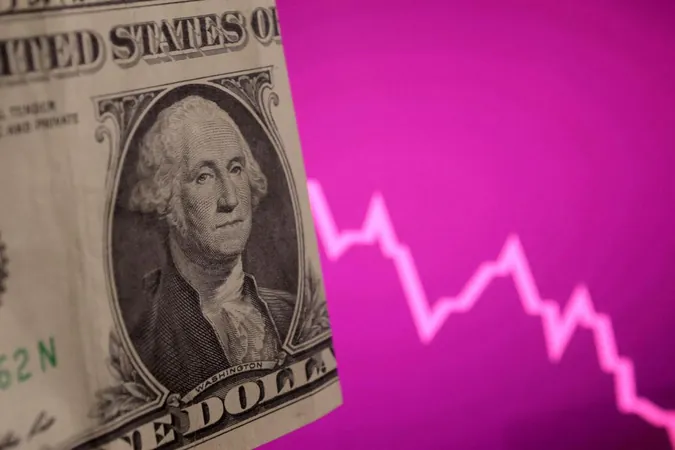
Back to the Future Turns 40: A Look at Its Tech Predictions vs. Today's AI Reality
2025-04-06
Author: Wei
It's hard to believe that it's been 40 years since Back to the Future first flew into our hearts and imaginations! Released in 1985, the film not only entertained but also presented a futuristic vision of 2015 filled with fantastical inventions like flying cars, hoverboards, and self-lacing shoes. As we look around in 2025, we can see that while some of these visions have not yet materialized, the advancements in Artificial Intelligence (AI) have introduced technologies that are just as impressive.
Cinematic Predictions: What Did Back to the Future Envision?
In Back to the Future Part II, several groundbreaking technologies were depicted, capturing the imagination of audiences:
- Flying Cars: Vehicles elevated above the chaos of traditional traffic.
- Hoverboards: Skateboards that glide effortlessly above the ground.
- Self-lacing Shoes: Footwear that fastens itself automatically.
- Weather Control: The ability to alter weather conditions at will.
- Video Calls & Wearable Tech: Advanced communication through screens integrated into our clothing.
- Interactive Garbage Cans: Waste bins that could engage with users.
- AI Waitstaff & Displays: Virtual assistants at our service.
- Smart Homes: Residences with automated systems to ease our daily lives.
- Robotic Dog Walkers: Machines taking our pets on walks without human intervention.
- Automated Gas Stations: Fully robotic fueling systems.
While many of these innovations still seem to be on the horizon, AI has propelled numerous revolutionary technologies into reality, some of which echo and even surpass those imagined in the film.
The AI Innovations of Today
Smart Assistants
Instead of flying heads, we now have sophisticated voice-activated assistants that play an integral role in our lives. Platforms like ChatGPT, Siri, and Alexa can converse naturally, control smart devices, and facilitate communication—all from a simple voice command.
Wearable Technology & Video Calls
The notion of video calls envisioned by Marty McFly is now commonplace, with platforms enabling seamless connectivity through virtual meetings, FaceTime, and smartwatch communications. Additionally, smartwatches can track health metrics and even enable direct calls, proving to be essential communication tools.
Augmented Reality (AR) and AI-enhanced glasses are another leap forward, with partnerships between companies like Meta and Ray-Ban resulting in smart glasses that provide real-time information and language translation.
Predictive AI in Shopping & Entertainment
With platforms like Netflix, Amazon, and Spotify implementing AI-tuned recommendation engines, we now have tools capable of anticipating our desires, enhancing our shopping and entertainment experiences.
AI in Content Creation
A variety of AI tools are revolutionizing content creation by generating text, images, and more, accommodating diverse audience preferences and needs in remarkable ways.
Smart Scheduling
Modern AI scheduling tools analyze workloads and strategically arrange tasks to enhance productivity. Innovations such as Gemini AI optimize scheduling by integrating with existing calendars and adjusting plans in real time.
AI Voice Cloning & Deepfakes
Remembering when Marty saw double, we now encounter technology that creates incredibly realistic audio and video imitations through AI voice cloning and deepfake advancements, raising both possibilities and ethical concerns in media.
Surprises & Disappointments
Generative AI
The concept of generative AI, which can create music, art, and code, has taken off, showcasing our advanced capabilities in both creativity and automation.
Real-Time Translation
Today’s devices seamlessly provide real-time translation abilities through apps and innovative gadgets, diminishing language barriers like never before.
Facial Recognition & Surveillance
Ubiquitous facial recognition technology, while convenient, raises important questions about privacy and consent in our increasingly monitored society.
Technologies Yet to Materialize
Though many imaginative predictions from the film remain unrealized, some noteworthy examples include:
- Self-lacing Shoes: While Nike produced a limited-edition version inspired by the film, they have yet to achieve widespread use.
- Flying Cars: Prototypes abound, but regulatory and safety hurdles hamstring mass adoption.
- True Hoverboards: While alternatives exist, no fully levitating boards as depicted in the film are commercially available yet.
- Weather Manipulation: We still cannot control weather patterns, facing ethical dilemmas in the attempt.
- Instant Food Hydration: Traditional cooking remains our go-to method for preparing meals.
- Fully Robotic Homes: While there are automated technologies, fully autonomous homes are still in the realm of speculative fiction.
Looking Ahead: The Future in 2065
Reflecting on four decades since Back to the Future first enchanted us, it’s evident that while some of the futuristic devices dreamed up by Doc Brown remain elusive, the rapid evolution of AI has significantly transformed our world. Looking toward 2065, experts predict AI will be deeply embedded in every aspect of our lives, leading innovations that will change our reality profoundly.
We face both unparalleled opportunities and substantial challenges, as AI begins to augment human capabilities in ways we've yet to fully comprehend. The role of AI will undoubtedly be central in shaping the world of 2065, and it is crucial for us to navigate this technological evolution consciously, ensuring it aligns with our values and benefits society as a whole.
The future awaits, and it promises to be just as thrilling as the ride in that iconic DeLorean!



 Brasil (PT)
Brasil (PT)
 Canada (EN)
Canada (EN)
 Chile (ES)
Chile (ES)
 Česko (CS)
Česko (CS)
 대한민국 (KO)
대한민국 (KO)
 España (ES)
España (ES)
 France (FR)
France (FR)
 Hong Kong (EN)
Hong Kong (EN)
 Italia (IT)
Italia (IT)
 日本 (JA)
日本 (JA)
 Magyarország (HU)
Magyarország (HU)
 Norge (NO)
Norge (NO)
 Polska (PL)
Polska (PL)
 Schweiz (DE)
Schweiz (DE)
 Singapore (EN)
Singapore (EN)
 Sverige (SV)
Sverige (SV)
 Suomi (FI)
Suomi (FI)
 Türkiye (TR)
Türkiye (TR)
 الإمارات العربية المتحدة (AR)
الإمارات العربية المتحدة (AR)